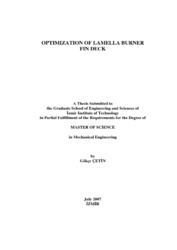Please use this identifier to cite or link to this item:
https://hdl.handle.net/11147/3920Full metadata record
| DC Field | Value | Language |
|---|---|---|
| dc.contributor.advisor | Özerdem, Mehmet Barış | en |
| dc.contributor.author | Çetin, Gökçe | - |
| dc.date.accessioned | 2014-07-22T13:52:41Z | - |
| dc.date.available | 2014-07-22T13:52:41Z | - |
| dc.date.issued | 2007 | en |
| dc.identifier.uri | http://hdl.handle.net/11147/3920 | - |
| dc.description | Thesis (Master)--Izmir Institute of Technology, Mechanical Engineering, Izmir, 2007 | en |
| dc.description | Includes bibliographical references (leaves: 90-92) | en |
| dc.description | Text in English; Abstract: Turkish and English | en |
| dc.description | xv, 92 leaves | en |
| dc.description.abstract | Lamella burner is a low NOx burner patented by BOSCH Thermotechnologies.In this study, different designs of fin deck, which is one of the major components of the lamella burner, are experimentally analyzed and optimized. After the optimization process, a numerical analysis was used for verification.Emissions are the most important properties for the gas fired boilers and directly related with the design of the burner parts where the combustion occurs. In the lamella burner, fin deck is the most related part with combustion. Combustion occurs on the fin deck surface hence, current fin deck design analysis and optimization is based on the emission rates in order to keep the lamella burner as low-emission (both NOx and CO)burner.This study mainly consists: summary of main parameters regarding combustion and fin deck, experimental analysis, and verification of optimized fin deck model with numerical simulation. Firstly, gas combustion and lamella burner are investigated. Physical conditions and combustion characteristics for fin deck are analyzed and layout parameters for fin deck are deducted. Afterwards, four new fin deck designs are introduced as alternatives for the current design. In the experimental part, emission, light back, flame lift, temperature and pressure drop tests are performed for serial and each new sample in the BOSCH Product Development Laboratories, Manisa. According to the test results, the most preferred sample is defined as optimized one.Test results are discussed to explain whether the fin deck samples are preferable or not. In the combustion curve performance test, CO values are measured. The comparison between the combustion curve test results show that CO formation is related to the fin deck geometry. Geometry affects flame stability because of the differences in mixture velocity distributions. The unburned gas in exhaust is one of the causes of the CO formation and influenced from the flame stability. Therefore,unburned gas mass fractions in exhaust are different for the samples with different geometries. This result is also numerically verified in combustion simulations of two different fin deck models, which one of them is considered as optimized sample. | en |
| dc.language.iso | en | en_US |
| dc.publisher | Izmir Institute of Technology | en |
| dc.rights | info:eu-repo/semantics/openAccess | en_US |
| dc.subject.lcc | TJ325. C42 2007 | en |
| dc.subject.lcsh | Gas-burners | en |
| dc.subject.lcsh | Combustion | en |
| dc.title | Optimization of lamella burner fin deck | en_US |
| dc.type | Master Thesis | en_US |
| dc.institutionauthor | Çetin, Gökçe | - |
| dc.department | Thesis (Master)--İzmir Institute of Technology, Mechanical Engineering | en_US |
| dc.relation.publicationcategory | Tez | en_US |
| item.grantfulltext | open | - |
| item.openairecristype | http://purl.org/coar/resource_type/c_18cf | - |
| item.cerifentitytype | Publications | - |
| item.openairetype | Master Thesis | - |
| item.languageiso639-1 | en | - |
| item.fulltext | With Fulltext | - |
| Appears in Collections: | Master Degree / Yüksek Lisans Tezleri | |
Files in This Item:
| File | Description | Size | Format | |
|---|---|---|---|---|
| T000659.pdf | MasterThesis | 1.15 MB | Adobe PDF |  View/Open |
CORE Recommender
Page view(s)
76
checked on Apr 22, 2024
Download(s)
52
checked on Apr 22, 2024
Google ScholarTM
Check
Items in GCRIS Repository are protected by copyright, with all rights reserved, unless otherwise indicated.